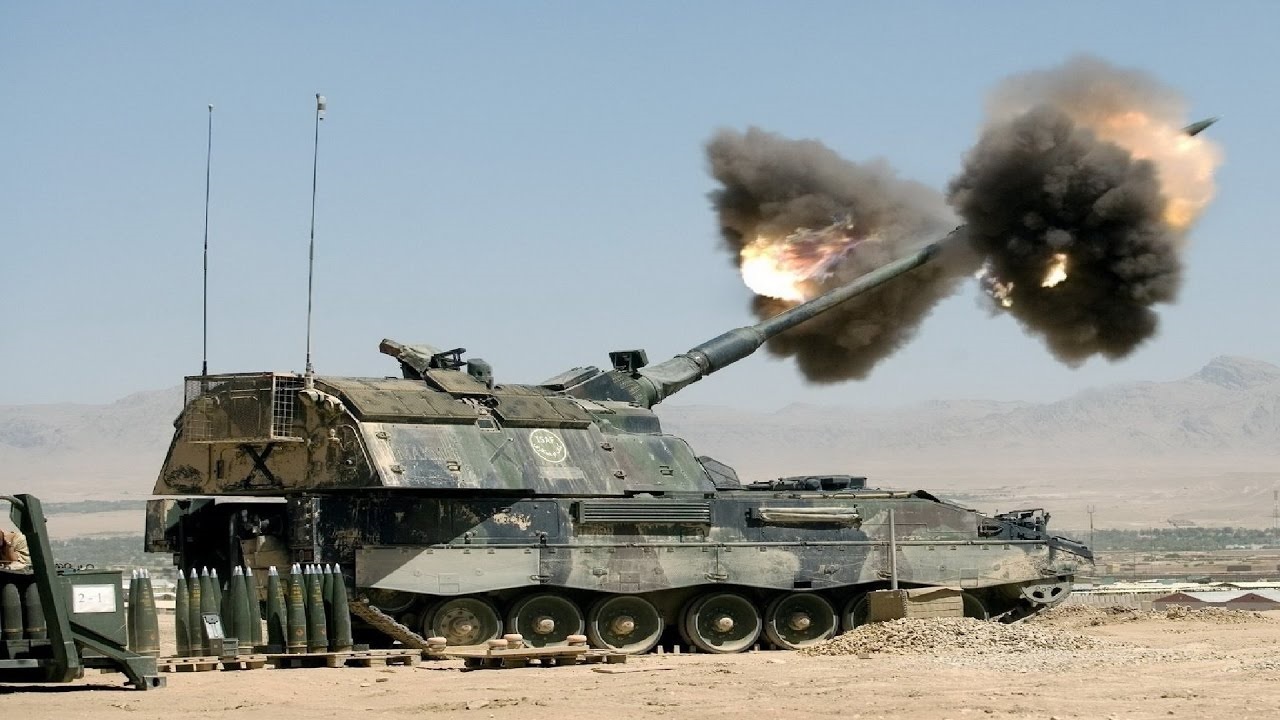A short video clip shared on social media earlier this week reported showing a German Panzerhaubitze 2000 (“armored howitzer 2000”), also known as a PzH 2000, in service with troops from the Ukrainian 43rd Separate Artillery Brigade in an undisclosed location.
The Italian military reportedly provided the vehicle, which had operated approximately 70 Pzh 2000s.
Last year, Rome had pledged to provide six to Kyiv, while the Netherlands also announced it would supply an additional five, and Germany further announced it would send a total of seven.
As of the start of this year, 22 have been delivered, with Germany providing ammunition and training.
The platform is also in use by a number of NATO partners including Croatia, Greece, Hungary, and Lithuania, while Qatar also operates a number of the German-made mobile howitzers.
High Rate of Fire
The PzH 2000, which is armed with an L52 155mm main gun, was developed by Krauss-Maffei Wegmann (KMW) and Rheinmetall in the 1980s and 1990s – first entering service in 1998.
The mobile howitzer, which features a tracked chassis, shares some components with the Leopard 2 main battle tank (MBT). The PzH 2000 is also equipped with phased array radar on the front glacis, which provides a measurement of the muzzle velocity for each round fired.
The vehicle is operated by a crew of five – including the commander, driver, gunner, and two loaders – while it offers NBC (nuclear, biological, and chemical) protection and a ventilation system for those operators.
It is comparable with standard NATO 155mm ammunition and is capable of a very high rate of fire. In burst mode, the PzH 2000 can fire three rounds in nine seconds, while it can fire between 10 and 13 rounds per minute continuously. The platform is also noted for its automatic support for up to five rounds in Multiple Round Simultaneous Impact (MRSI), while replenishment of shells is automated. The crew’s pair of loaders can load upwards of 60 shells and propelling charges in less than 12 minutes.
It is also compatible with the M982 Excalibur extended-range guided artillery shells, as well as the German SMAr 155 guided artillery shells.
Exceeding Recommendations
The weapon has been seen as highly effective in recent fighting. However, Ukrainian forces have greatly exceeded the maximum of 100 shots per day that German designers considered a “high-intensity mission.” That has placed stress on the weapon’s loading mechanisms, and some of the mobile howitzers have been pulled from active service.
As previously reported, Ukrainian forces also reportedly attempted to figure special ammunition at too far a distance, putting yet more pressure on the guns and causing as many as one-third of them to fail on the battlefield.
Last year, Lithuania undertook repair efforts – and refurbished six PzH 2000s that were returned to service in December. In addition, another 15 are now being serviced in Slovakia.
More Coming from Germany
Berlin announced last month that it would purchase up to 28 new PzH 2000 mobile howitzers for use with its Bundeswehr to replace the platforms sent to Ukraine.
Italian 155mm self-propelled guns PzH 2000 in service with the 43rd OABr., with additional IGEL armor plates, which enhance the roof armor of self-propelled guns, which allows increasing the protection of the tower from hitting cumulative ammunition pic.twitter.com/z7AskXdVZ3
— Feher_Junior (@Feher_Junior) April 3, 2023
German parliamentarians have already approved the allocation of €184 million ($200 million U.S.) for the purchase of PzH 2000 howitzers. The funds will be allocated within the framework of the Modernization Initiative, a security policy instrument of the federal government aimed at military support for partner countries.
“Since the German Armed Forces have transferred PzH 2000 to Ukraine from their stocks, the new howitzers are financed within the framework of the Modernization Initiative,” the German Ministry of Defense said in a statement to the media.
Author Experience and Expertise:
A Senior Editor for 19FortyFive, Peter Suciu is a Michigan-based writer. He has contributed to more than four dozen magazines, newspapers, and websites with over 3,200 published pieces over a twenty-year career in journalism. He regularly writes about military hardware, firearms history, cybersecurity, politics, and international affairs. Peter is also a Contributing Writer for Forbes and Clearance Jobs. You can follow him on Twitter: @PeterSuciu.

